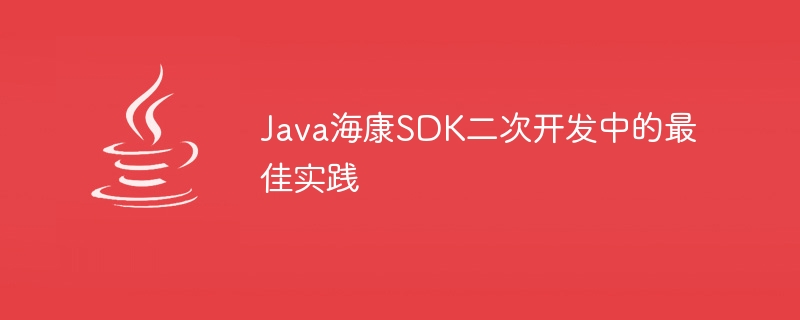Best practices in secondary development of Java Hikvision SDK

Best Practices in Secondary Development of Java Hikvision SDK
Abstract:
With the widespread application of modern monitoring technology, Hikvision provides SDK (Software Development Kit) has become the first choice for many developers. This article will introduce the best practices in secondary development of Java Hikvision SDK and provide some code examples.
- Connect the device
Before using the Hikvision SDK, you first need to connect the device you want to operate. The following is a sample code for connecting a device:
import com.sun.jna.NativeLong;
import com.sun.jna.Pointer;
public class DeviceConnection {
private static final int TIMEOUT = 5000; // 连接超时时间,单位为毫秒
public static NativeLong login(String ip, int port, String username, String password) {
HCNetSDK.NET_DVR_DEVICEINFO_V30 deviceInfo = new HCNetSDK.NET_DVR_DEVICEINFO_V30();
NativeLong lUserID = HCNetSDK.NET_DVR_Login_V30(ip, port, username, password, deviceInfo);
if (lUserID.longValue() == -1) {
System.err.println("登录设备失败,错误码:" + HCNetSDK.NET_DVR_GetLastError());
}
return lUserID;
}
public static void logout(NativeLong lUserID) {
if (!HCNetSDK.NET_DVR_Logout(lUserID)) {
System.err.println("登出设备失败,错误码:" + HCNetSDK.NET_DVR_GetLastError());
}
}
public static void main(String[] args) {
String ip = "192.168.1.100";
int port = 8000;
String username = "admin";
String password = "123456";
NativeLong lUserID = login(ip, port, username, password);
// do something...
logout(lUserID);
}
}- Get device status
Before performing other operations, we usually need to obtain the running status of the device. The following is a sample code to obtain device status:
import com.sun.jna.NativeLong;
public class DeviceStatus {
public static boolean isDeviceOnline(NativeLong lUserID) {
HCNetSDK.NET_DVR_WORKSTATE_V30 deviceStatus = new HCNetSDK.NET_DVR_WORKSTATE_V30();
if (!HCNetSDK.NET_DVR_GetDVRWorkState_V30(lUserID, deviceStatus)) {
System.err.println("获取设备状态失败,错误码:" + HCNetSDK.NET_DVR_GetLastError());
}
return deviceStatus.dwDeviceStatic == 1;
}
public static void main(String[] args) {
NativeLong lUserID = new NativeLong(12345); // 假设已经登录并获取到了lUserID
if (isDeviceOnline(lUserID)) {
System.out.println("设备在线");
} else {
System.out.println("设备离线");
}
}
}- Set device parameters
Hikvision SDK provides a rich interface to set various parameters of the device. The following is a sample code for setting device time:
import com.sun.jna.NativeLong;
public class DeviceSetting {
public static boolean setDeviceTime(NativeLong lUserID) {
HCNetSDK.NET_DVR_TIME time = new HCNetSDK.NET_DVR_TIME();
time.dwYear = 2022;
time.dwMonth = 7;
time.dwDay = 1;
time.dwHour = 12;
time.dwMinute = 0;
time.dwSecond = 0;
if (!HCNetSDK.NET_DVR_SetDVRConfig(lUserID, HCNetSDK.NET_DVR_SET_TIMECFG, 0, time.getPointer(),
time.size(), null)) {
System.err.println("设置设备时间失败,错误码:" + HCNetSDK.NET_DVR_GetLastError());
}
return true;
}
public static void main(String[] args) {
NativeLong lUserID = new NativeLong(12345); // 假设已经登录并获取到了lUserID
if (setDeviceTime(lUserID)) {
System.out.println("设置设备时间成功");
} else {
System.out.println("设置设备时间失败");
}
}
}Summary:
Through the above sample code, we have learned some best practices in the secondary development of Java Hikvision SDK, including device Connect, get device status and set device parameters. In actual development, we can further use the interface provided by Hikvision SDK to complete more complex functions according to project needs. I hope this article will be helpful to developers who are developing Java Hikvision SDK.
The above is the detailed content of Best practices in secondary development of Java Hikvision SDK. For more information, please follow other related articles on the PHP Chinese website!

Hot AI Tools

Undresser.AI Undress
AI-powered app for creating realistic nude photos

AI Clothes Remover
Online AI tool for removing clothes from photos.

Undress AI Tool
Undress images for free

Clothoff.io
AI clothes remover

AI Hentai Generator
Generate AI Hentai for free.

Hot Article

Hot Tools

Notepad++7.3.1
Easy-to-use and free code editor

SublimeText3 Chinese version
Chinese version, very easy to use

Zend Studio 13.0.1
Powerful PHP integrated development environment

Dreamweaver CS6
Visual web development tools

SublimeText3 Mac version
God-level code editing software (SublimeText3)

Hot Topics
 Square Root in Java
Aug 30, 2024 pm 04:26 PM
Square Root in Java
Aug 30, 2024 pm 04:26 PM
Guide to Square Root in Java. Here we discuss how Square Root works in Java with example and its code implementation respectively.
 Perfect Number in Java
Aug 30, 2024 pm 04:28 PM
Perfect Number in Java
Aug 30, 2024 pm 04:28 PM
Guide to Perfect Number in Java. Here we discuss the Definition, How to check Perfect number in Java?, examples with code implementation.
 Random Number Generator in Java
Aug 30, 2024 pm 04:27 PM
Random Number Generator in Java
Aug 30, 2024 pm 04:27 PM
Guide to Random Number Generator in Java. Here we discuss Functions in Java with examples and two different Generators with ther examples.
 Armstrong Number in Java
Aug 30, 2024 pm 04:26 PM
Armstrong Number in Java
Aug 30, 2024 pm 04:26 PM
Guide to the Armstrong Number in Java. Here we discuss an introduction to Armstrong's number in java along with some of the code.
 Weka in Java
Aug 30, 2024 pm 04:28 PM
Weka in Java
Aug 30, 2024 pm 04:28 PM
Guide to Weka in Java. Here we discuss the Introduction, how to use weka java, the type of platform, and advantages with examples.
 Smith Number in Java
Aug 30, 2024 pm 04:28 PM
Smith Number in Java
Aug 30, 2024 pm 04:28 PM
Guide to Smith Number in Java. Here we discuss the Definition, How to check smith number in Java? example with code implementation.
 Java Spring Interview Questions
Aug 30, 2024 pm 04:29 PM
Java Spring Interview Questions
Aug 30, 2024 pm 04:29 PM
In this article, we have kept the most asked Java Spring Interview Questions with their detailed answers. So that you can crack the interview.
 Break or return from Java 8 stream forEach?
Feb 07, 2025 pm 12:09 PM
Break or return from Java 8 stream forEach?
Feb 07, 2025 pm 12:09 PM
Java 8 introduces the Stream API, providing a powerful and expressive way to process data collections. However, a common question when using Stream is: How to break or return from a forEach operation? Traditional loops allow for early interruption or return, but Stream's forEach method does not directly support this method. This article will explain the reasons and explore alternative methods for implementing premature termination in Stream processing systems. Further reading: Java Stream API improvements Understand Stream forEach The forEach method is a terminal operation that performs one operation on each element in the Stream. Its design intention is






